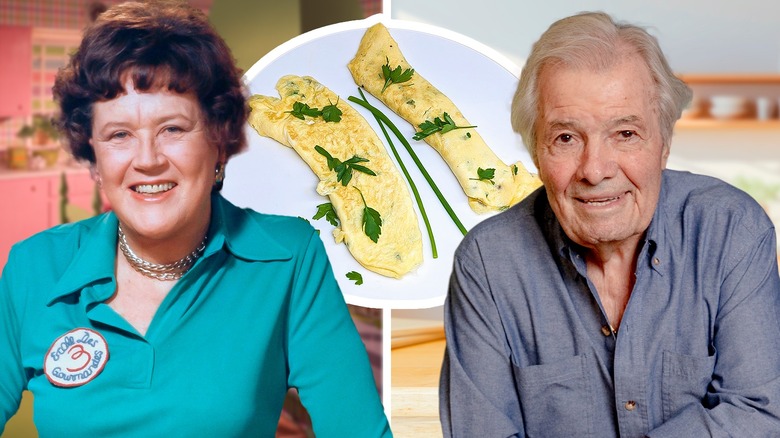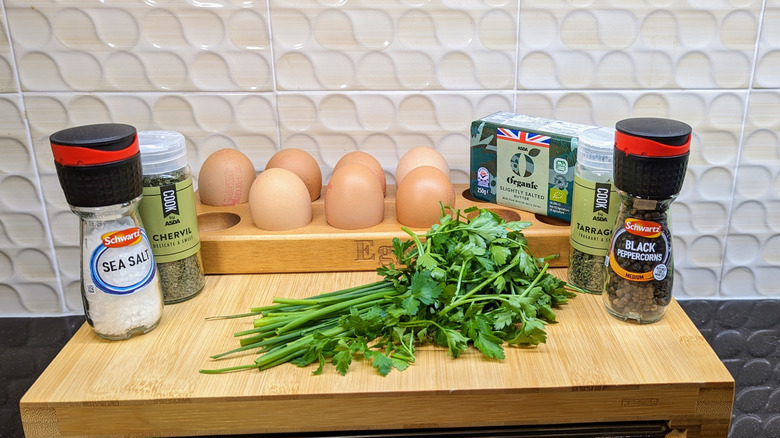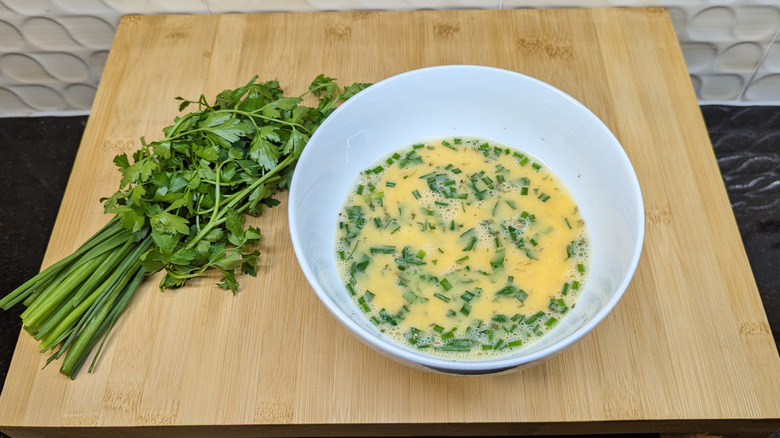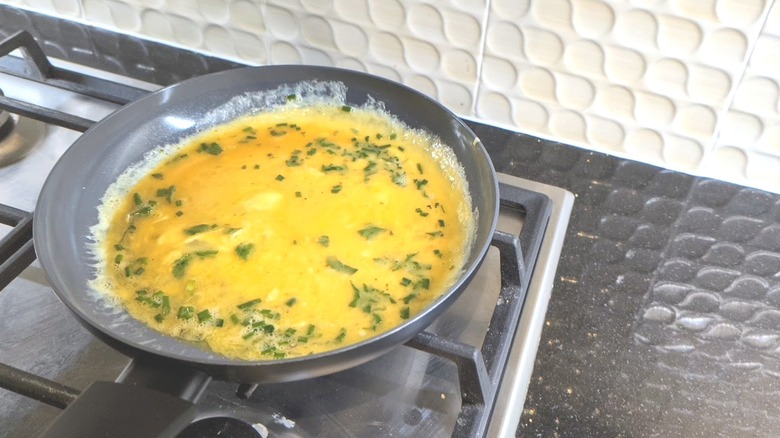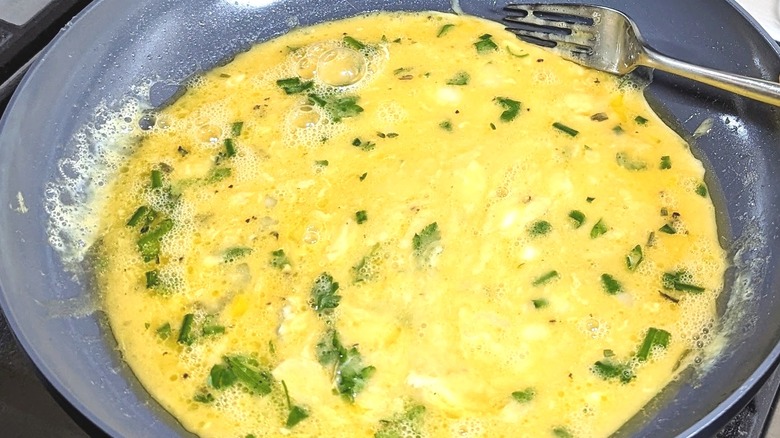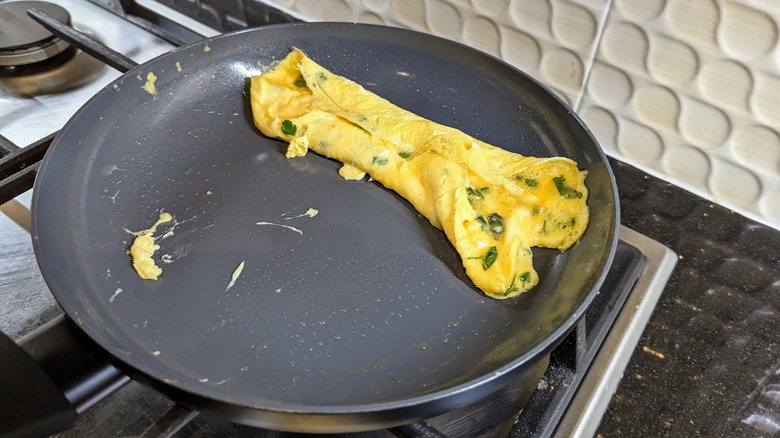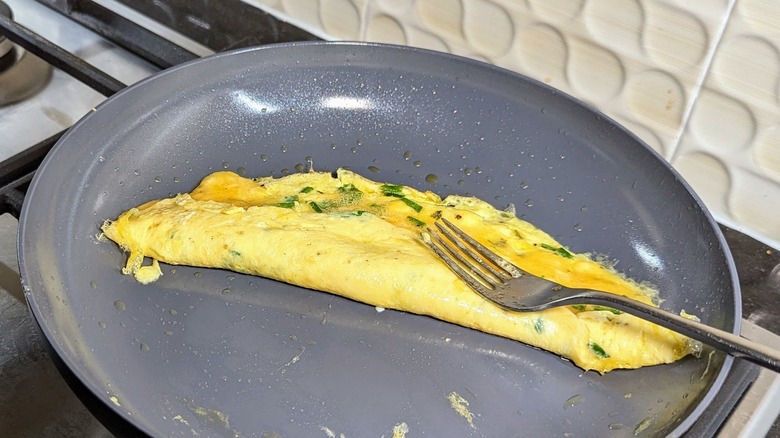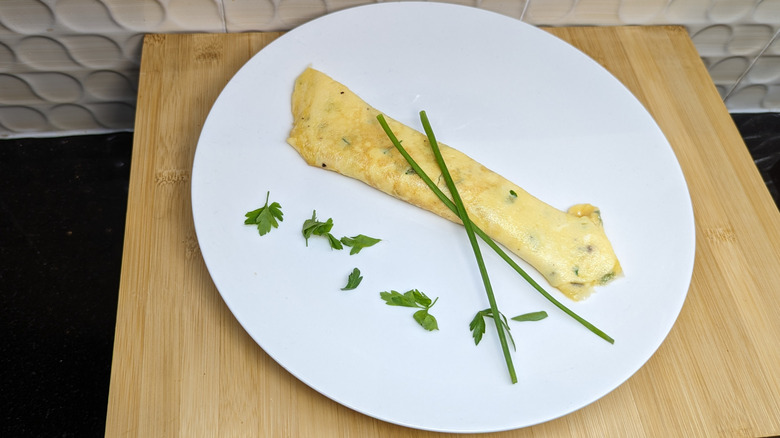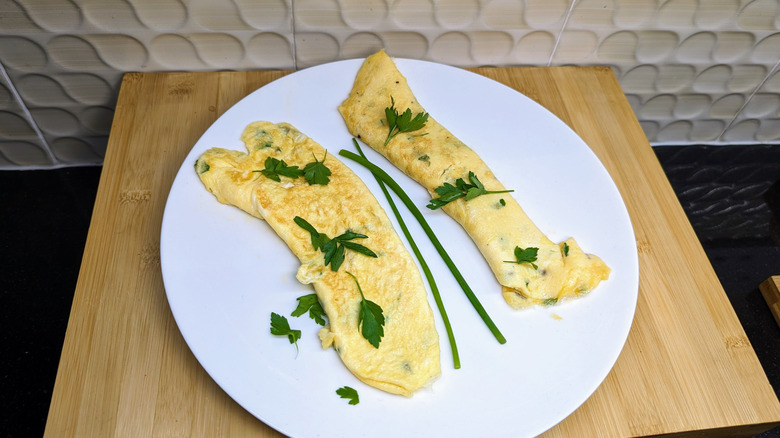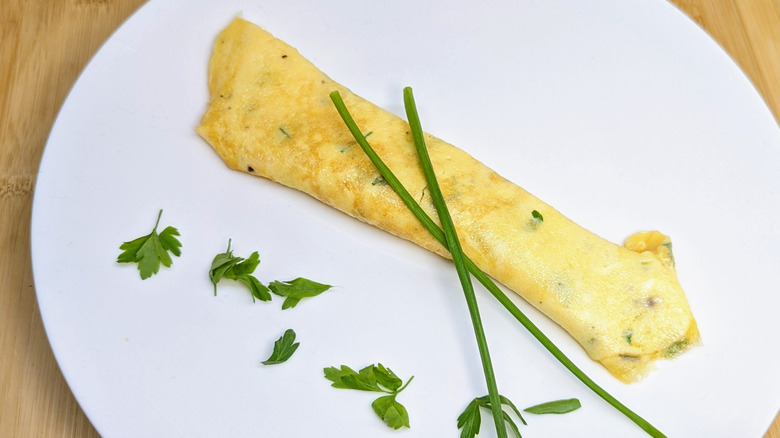Julia Child Vs Jacques Pépin: Who Makes The Better French Omelette?
Welcome to a culinary battle of epic proportions as the legendary Julia Child takes on the iconic Jacques Pépin in a French omelette showdown. Both of these renowned chefs are celebrated for their love of French cooking, and it doesn't get much simpler or more traditional than a French omelette.
But which of these chefs is the true master of the French omelette? Though they were friends in real life and hosted a cooking show together — "Julia and Jacques Cooking at Home" — their cooking approaches had distinct differences, as did their recipe for a French omelette. Since Julia Child passed away more than 20 years ago at 91, this showdown can sadly no longer take place in person. Instead, I will be taking on the challenge of comparing these two classic French omelettes side by side, recreating each one as closely as possible, and deciding the overall winner. So join me as I jump into this delicious contest, and discover whose French omelette takes the crown.
The chefs
Julia Child was a pioneer in the 1960s, hosting her own cooking show at a time when women were not commonly found in professional kitchens. Although not French, learned some of the best kept secrets at culinary school in France, after attending the world-renowned Cordon Bleu cooking school in Paris, From there she made French cuisine more accessible to home cooks in America with tips that would make every meal a piece of art. She quickly became a household name, loved for her enthusiasm for cooking and sense of humor.
Jacques Pépin is a classically trained chef, born in France, near Lyon, and the master of culinary perfection. His legendary career began at 13, and he was, at one point, Charles de Galle's personal chef. Pépin is known for his precision cooking and has taught Culinary Arts at Boston University for the last 30 years.
These two legendary chefs have given so much to the world of cooking over the years, and their French omelette recipes are testament to their differing styles. Of course, since this is a contest, there has to be a winner, so let's get started and find out who it will be.
The ingredients
As both Julia Child and Jacques Pépin are classically trained in French cuisine, the ingredients for their recipes are very similar. Eggs are, of course, the star of the show, and the higher quality you can get, the better your end dish will be. Pépin recommends using organic eggs where possible – in general, you will see the difference in the rich, dark color of the yolk — but you should know the difference between free-range and cage-free eggs and use the former if you can. Since eggs are pretty much the only ingredient in this omelette, you can use as many or as few as you wish, depending on how many people you want to serve. However, a three-egg omelette is a good place to start.
Both chefs cook their omelettes in butter, and like most French recipes, they don't shy away from it. Plenty of butter in the pan will ensure the omelette doesn't stick, preventing you from folding it to perfection. A blend of classic French herbs, including parsley, chives, tarragon, and chervil, completes the ingredients list. Though fresh herbs are preferred, if you struggle to get fresh tarragon and chervil like me, you can replace them with the dried form, though you will not need as much of it.
Preparation
With such a simple dish and so few steps, preparing the eggs properly is crucial. As a busy home cook, you may be used to cracking the eggs with one hand into a bowl, giving them a two-second stir with a fork, and pouring them straight into the pan, but for this recipe, that ain't gonna cut it. Stirring the eggs properly is an important step in the success of this dish, so you don't want to skimp on it just to save a few seconds.
Both Julia Child and Jacques Pépin emphasize the importance of incorporating the eggs and yolks together properly. Pépin explains that this is to prevent a long string of egg whites in the pan. Combining the two parts properly will allow the omelette to have a more even color, texture, and flavor. So, the first step is to mix the eggs thoroughly with a fork.
Chop the fresh herbs finely, ready to add to the egg mixture directly before cooking. The more finely you chop them, the more aromatic flavor will be released into your dish. However, that will diminish as time goes on, so chop them as close to cooking time as possible to get the best possible fragrance.
Cooking the omelette - Julia
Jacques Pépin told The New York Times that Julia Child "added conviviality and unpretentiousness to the French traditions," which is evident in her approach to cooking her French omelette. Famously ready to eat after a mere 14 seconds in the pan, her no-nonsense method involves keeping the pan moving at all times, which encourages the eggs to cook evenly and will prevent them from sticking.
Surprisingly, she doesn't use any utensils, relying instead on the constant motion of the pan to move the eggs around and shape the omelette. Since I have always used a spatula or silicone spoon to make an omelette, I was skeptical about how successful the no-utensil method would be, but I was surprised to find that the shaking motion had the same effect. For a slightly easier option, Child advocated using a fork in an episode of her cooking show, allowing a bit more control than the utensil-free method but still resulting in the same final dish.
If, like me, you don't quite manage the perfect omelette in 14 seconds, don't despair. When Child appeared on Good Morning America in 1980 to prepare the omelette, she said it should take 20 seconds. So even at a snail's-pace — albeit a pretty fast snail — you will still be true to Child's recipe even if you need a few seconds more.
Cooking the omelette - Jacques
In true Jacques Pépin style, he takes a more measured approach to cooking his French omelette, with the eggs spending around four times as long in the pan as in Julia Child's recipe. He explained that he doesn't like to cook it too quickly, so the eggs will be set more in this recipe than in Child's. He starts by adding two tablespoons of butter to the pan and letting it heat up until it foams, then adds the fully mixed eggs to the pan.
When the eggs hit the pan, he starts stirring with a fork. In the name of increasing the life of your non-stick pan, you may wish to use a silicone utensil instead, but the key is to stir gently but consistently to allow the eggs to set nicely. You should also shake the pan with the other hand as you stir.
After about 30 seconds, he stops stirring and tips the pan away to allow the eggs to move toward the far end of the pan, ready for the hardest part — the fold.
Folding the omelette - Julia
If you thought the utensil-free part of Julia Child's omelette was over and it was time to get your spatula out to fold it into a beautiful oblong — I'm afraid not. Child's omelette folding is just like her cooking style — bold, fast, and to the point. The folding step of her omelette is just an extension of the pan shaking that the whole 14 seconds entails, with a bit of a higher flip to get the omelette to fold in on itself.
During her Good Morning, America appearance, Child explained to the host that the trick is to shake the pan like you have dried beans, saying, "When all of the beans turn over by themselves, you've got it." She got him to demonstrate this technique using beans. Keep this in mind as you shake the pan, and add in a bit of a pancake-style flick at the end to fold the omelette into shape. You can then tip the pan carefully so the omelette falls out onto the plate, perfectly folded and beautifully presented. Maybe. I personally found the folding of Child's omelette to be by far the hardest part, and even after numerous attempts, the presentation still felt extremely "rustic." Still, there is no doubt that it is possible to make a folded French omelette using no utensils at all; it will just take a bit of practice to get it looking as elegant as Child's.
Folding the omelette - Jacques
Jacques Pépin's folding method could not be more different from Julia Child's. In typical Pépin fashion, his fold is precise and elegant, and he takes his time to get it right, compared to Child's speedy, simplistic fold. Once the omelette has set, after about a minute in the pan, he gently pulls back the edge of the omelette with the fork, and begins to roll the egg from the middle of the pan toward the edge.
He describes it as rolling a carpet and takes his time and care to ensure it looks as smooth as possible by using the fork to guide it. The last step, to fold the edge closest to the outside of the pan, involves banging that side of the saucepan firmly on the cooker top to release it and allow you to roll the omelette onto the plate with perfect presentation.
I found Pépin's omelette much easier to fold because I could use cutlery! The longer cooking time also seemed to help, as the eggs were fully set and stuck to each other in true omelette fashion, making rolling them pretty easy. Pépin points out that the omelette should be pale and never browned, with its beautiful white color with flecks of green enhancing the elegant presentation.
Presentation
Because the ingredients in the two omelette recipes are virtually identical, the presentation is not wildly different. The main distinction comes from the two folding techniques. Julia Child's omelette looks more rustic on the plate, though this may have been due to my lack of practice with the shake-and-flip technique!
On the other hand, Jacques Pépin's omelette looks elegant, even on my first attempt at folding it. It has a more even, cylindrical shape since the fork was used to fold it and tuck in the edges, whereas Child's was simply flipped and then turned out onto the plate.
For both omelettes, as with all French omelettes, simplicity is key when presenting the dish. In a meal with so few ingredients, you don't want to adorn the plate with heavy and distracting garnishes, instead letting the omelette speak for itself. A few leaves of the fresh herbs you used in the mixture should be enough to give a minimalist, elegant presentation. Just be sure to always plate with the seam facing down, ensuring a lovely smooth finish is presented to your guests.
Taste comparison
As a lover of a classic cheese omelette, I was surprised at how tasty both of these omelettes were, considering that egg is very much the main ingredient. I usually cook my omelette in a drizzle of olive oil (and finding the right one harder than you'd think), so the richness of the butter added a real creaminess that made both versions delicious.
Since both recipes used the same ingredients, the main difference in flavor and texture comes down to the length of time the eggs were cooked. With only 14 (ish) seconds in the pan, Julia Child's eggs were very lightly cooked, something that I wasn't expecting to enjoy. To my surprise, this gave the omelette an utterly delightful, airy texture. The freshness from the herbs, richness of the butter, and creaminess of the eggs meant this omelette was a big hit for both flavor and texture — especially if you enjoy your eggs slightly underdone.
Jacques Pépin's omelette also had the creamy texture from the butter and brightness of herbs, but the eggs were more thoroughly cooked, which gave the more familiar omelette texture that most of us would recognize. It has a brilliantly smooth finish that matches the elegant presentation. If you like a regular stuffed omelet, you will likely enjoy Pépin's French omelette. The simple recipe allows the eggs to shine while retaining the wonderful silky texture we love.
Verdict
So now for the big question — whose French omelette is best? The good news is that there are no losers here since both omelettes are a triumph of flavor and texture. Which one you prefer will likely come down to your personal egg preference and how you feel about eggs teetering on the edge of being undercooked.
The big difference for me was the ease of cooking; for that reason, there is one recipe I will be recreating again and again. I found Jacques Pépin's omelette much easier to manage, especially when folding and presenting. The utensil-free method of Julia Child was unique and certainly fits with her straightforward approach to French cuisine, but I found it frantic and, to be honest, a little bit stressful! It took me multiple attempts to make an omelette that was even close to being presentable, whereas Pépin's worked the first time.
Though Julia Child's 14-second French omelette is certainly a great option if you are in a hurry, I would rather take the extra 46 seconds and try Jacques Pépin's method. With a silky smooth omelette that is easy to prepare and looks fantastic, you can't go wrong with this classic French dish.
